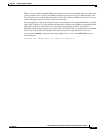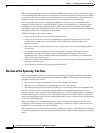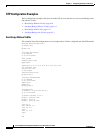
8-4
Cisco IOS Software Configuration Guide for Cisco Aironet Access Points
OL-29225-01
Chapter 8 Configuring Spanning Tree Protocol
Understanding Spanning Tree Protocol
When a access point/bridge receives a configuration BPDU that contains superior information (lower
access point/bridge ID, lower path cost, and so forth), it stores the information for that port. If this BPDU
is received on the root port of the access point/bridge, the access point/bridge also forwards it with an
updated message to all attached LANs for which it is the designated access point/bridge.
If a access point/bridge receives a configuration BPDU that contains inferior information to that
currently stored for that port, it discards the BPDU. If the access point/bridge is a designated access
point/bridge for the LAN from which the inferior BPDU was received, it sends that LAN a BPDU
containing the up-to-date information stored for that port. In this way, inferior information is discarded,
and superior information is propagated on the network.
A BPDU exchange results in these actions:
• One access point/bridge is elected as the spanning-tree root.
• A root port is selected for each access point/bridge (except the spanning-tree root). This port
provides the best path (lowest cost) when the access point/bridge forwards packets to the
spanning-tree root.
• The shortest distance to the spanning-tree root is calculated for each access point/bridge based on
the path cost.
• A designated access point/bridge for each LAN segment is selected. The designated access
point/bridge incurs the lowest path cost when forwarding packets from that LAN to the
spanning-tree root. The port through which the designated access point/bridge is attached to the
LAN is called the designated port.
• Interfaces included in the spanning-tree instance are selected. Root ports and designated ports are
put in the forwarding state.
• All interfaces not included in the spanning tree are blocked.
Election of the Spanning-Tree Root
All access point/bridges in the Layer 2 network participating in STP gather information about other
access point/bridges in the network through an exchange of BPDU data messages. This exchange of
messages results in these actions:
• The election of a unique spanning-tree root for each spanning-tree instance
• The election of a designated access point/bridge for every LAN segment
• The removal of loops in the network by blocking Layer 2 interfaces connected to redundant links
For each VLAN, the access point/bridge with the highest access point/bridge priority (the lowest
numerical priority value) is elected as the spanning-tree root. If all access point/bridges are configured
with the default priority (32768), the access point/bridge with the lowest MAC address in the VLAN
becomes the spanning-tree root. The access point/bridge priority value occupies the most significant bits
of the access point/bridge ID.
When you change the access point/bridge priority value, you change the probability that the access
point/bridge will be elected as the root access point/bridge. Configuring a higher value decreases the
probability; a lower value increases the probability.
The spanning-tree root is the logical center of the spanning-tree topology. All paths that are not needed
to reach the spanning-tree root from anywhere in the network are placed in the spanning-tree blocking
mode.


















